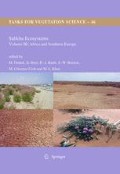Abstract
Salinization is one of the major problems for food production in Egypt. It has significantly impaired agricultural productivity. The total area of salt affected soils is estimated to be 1.8 million ha. These are mainly located along the Red sea coast, in the Mediterranean part, some areas in middle, western and eastern parts of the Nile delta, El Fayoum, Wadi El Natroun and the Oasis in the western desert area. Out of these saline areas salt marshes are important habitats for grazing animals, waterfowl and fish. They are integral components of the coastal and inland ecosystems of the country with a great potential as a source for many raw materials like food for human, animal feeds, fiber materials, habitat for fish, insects,etc.). However these habitats are under threat due to the uncontrolled human and orther biotic interferences. An attempt will be made here to give some evaluations on these salt marshes and their potential role in the Sabkhas of Egypt.
Access this chapter
Tax calculation will be finalised at checkout
Purchases are for personal use only
References
Boulos L (1995) Flora of Egypt checklist. Al Hadara, Gairo, pp 203
El-Khouly AA (2001) Plant diversity in the dry land habitats of Siwa Oasis in the Western desert of Egypt. J Env Sci, Mansoura University 22:125–143
El- Khouly AA, Zahran MA (2002) On the ecology of the halophytic vegetation of the oases in Egypt. Proceedings of the International Symposium on the optimum resources utilization in salt-affected ecosystems in arid and semi-arid regions, pp 277–286, 8–10 Apr 2002, Cairo, Egypt
El-Khouly AA, Khedr AA (2000) Species diversity and phenology in the wetland vegetation of Sewa Oasis, in the Western desert of Egypt. Desert Inst Bull Egypt 50:239–258
El Shaer HM (1981) A comparative nutrition study on sheep and goats grazing Southern Sinai desert range with supplements. Ph.D. Thesis, Fac. Agric. Ain Shams Univ. Egypt
El Shaer HM (2009) Potential role of Sabkhas in Egypt: an overview. In: Ashraf et al (eds) Salinity and water stress – improving crop efficiency, Tasks for vegetation Science – 44. Springer Science and Business Media BV, the Netherlands, pp 221–228
El Shaer HM, Attia Ismail SA (2002) Halophytes as animal feeds: potentiality, constraints, and prospects. Proceedings of international symposium on the optimum resources utilization in salt-affected ecosystems in arid and semi-arid regions, pp 411–418, 8–10 Apr 2002, Cairo, Egypt
El Shaer HM, Zahran MA (2002) Utilization of halophytes in Egypt: an overview. In: Proceedings of the international conference on Halophyte utilization and regional sustainable development of agriculture. Huanghua, Shijiazhnag, China, pp 14–20, Sept 2001
Khedr AA (1999) Floristic composition and phytogeography in a Mediterranean deltaic lake (Lake Burollos), Egypt. Ecologia Meditternea 25:1–11
Khedr AA, Zahran MA (2002) The salt marsh visitation of lake Bardawil, North Sinai, an overview. Proceedings international symposium on the optimum resources utilization in salt-affected ecosystems in arid and semi-arid regions, pp 339–345, 8–10 Apr 2002, Cairo, Egypt
Menzel U, Leith H (1998) Tabulation of halophytes reported as utilized in different publications and handbook. In: Hamdy A, Leith Fl, Todorovic M, Moschenko M (eds) Halophytes uses in different climates, Biometerology Ii. Bbackuys, Leiden, pp 127–133
Mohammed NE (1980) Studies in the genus Juncus in Egypt. M.Sc. Thesis, Fac. Sci., Cairo Univ. Egypt
Öztürk M, Alyanak I, Sakcali S, Guvensen A (2005) Multipurpose plant systems for renovation of waste waters. Arab J Sci Eng 30(2C):17–28
Öztürk M, Guvensen A, Gork G, Gork C (2006) An overview of the coastal zone plant diversity and management strategies in the Mediterranean region of Turkey. In: Öztürk et al (eds) Biosaline agriculture and salinity tolerance in plants. Birkhauser Verlag, Basel Switzerland, pp 89–100
Öztürk M, Guvensen A, Gücel S (2008) Ecology and economic potential of halophytes – a case study from Turkey. In: Kafi, Khan (eds) Crop and forage production using saline waters. NAM S & T Centre, Daya, House-Delhi, India, pp 255–264
Serag MS, Khedr AA, Zahran MA, Willis AJ (1999) Ecology of some aquatic plants in polluted water courses, Nile Delta, Egypt. J Union Arab Biol 9(B):85–97
Serag MS, Zahran MA, Khedr AA (2002) Ecology and economic potentialities of the dominant salt-tolerant reeds and rushes in the nile delta. Proceedings of International Symposium on the optimum resources utilization in salt-affected ecosystems in arid and semi-arid regions, pp 245–256, 8–10 Apr 2002, Cairo, Egypt
Shaheen SE (1998) Geoenvironmental studies on Bardawil lagoon and its surroundings, North Sinai, Egypt. PhD Thesis, Faculty of Science, Mansoura University, Mansonra, Egypt
Snogerup S (1993) A revision of Juncus subgen. Juncus (Juncaceae). Willdenowia 23:23–73
Squires VR, Ayoub AT (1994) Halophytes as resource for livestock and for rehabilitation of degraded lands. In: Proceedings of international workshop on halophytes for reclamation of saline wasteland and as a resource for livestock: problems and prospects. Kluwer Academic, London, pp 315
Szabolcs I (1994) Salt affected soils as ecosystem for halophytes. In: Squires VR, Ayoub AT (eds), Halophytes as a resource for livestock and for rehabilitation of degraded lands, Kluwer Academic. pp 19
Zahran MA (1993) Juncus and Kochi fiber- and fodder-producing halophytes under salinity and aridity stress. In: Pessarakli M (ed) Plant and crop stress. New York, Basal, Hong Kong, pp 505–528
Zahran MA, Willis AJ (2002) The plant life of the River Nile in Egypt. Marc, Reyadh, Suadi Arabia
Author information
Authors and Affiliations
Corresponding author
Editor information
Editors and Affiliations
Rights and permissions
Copyright information
© 2010 Springer Science+Business Media B.V.
About this chapter
Cite this chapter
Shaer, H.M.E. (2010). Potential Role of Salt Marshes in the Sabkhas of Egypt. In: Öztürk, M., Böer, B., Barth, HJ., Clüsener-Godt, M., Khan, M., Breckle, SW. (eds) Sabkha Ecosystems. Tasks for Vegetation Science, vol 46. Springer, Dordrecht. https://doi.org/10.1007/978-90-481-9673-9_11
Download citation
DOI: https://doi.org/10.1007/978-90-481-9673-9_11
Published:
Publisher Name: Springer, Dordrecht
Print ISBN: 978-90-481-9672-2
Online ISBN: 978-90-481-9673-9
eBook Packages: Biomedical and Life SciencesBiomedical and Life Sciences (R0)

